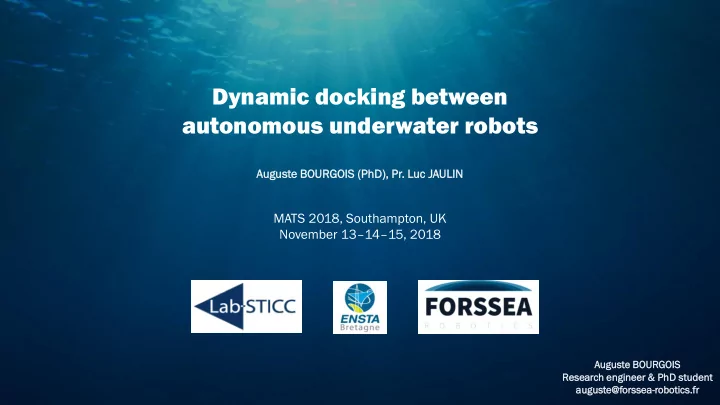

Dynamic docking between autonomous underwater robots August ste BOURGOIS OIS (PhD), Pr. Luc JAULIN MATS 2018, Southampton, UK November 13 – 14 – 15, 2018 August ste e BOURGO GOIS IS Resea search engineer ineer & Ph PhD studen dent august ste@f e@for orss ssea-robotic tics. s.fr fr
Introduction AUV operations Remora project AUV deployment from AUVs can be equipped with different sensors a surface vessel, using to achieve various missions: a LARS (Subsea World • Cameras News) Acoustic sensors (Multibeam, subbottom • profiler, sidescan …) • Magnetometers (c) (a) AUVs have limitations: • Cost/duration of deployment/recovering of the AUV a) ECA AUV inspecting a (b) pipeline • Limited battery life b) MBARI AUV mapping • Limited storage capacity seafloor c) Thales AUV looking for underwater mines Auguste BOURGOIS - Forssea Robotics – MATS 2018 2
Introduction AUV operations Remora project Several issues must be solved: • The tether influence on the ROV's trajectory is unknown and quite unpredictable • The AUV and the surface vessel are moving • The ROV ought not crash onto fragile parts of the AUV Autonomous dynamic docking of an ROV and an AUV The ROV ought not tie knots with its tether • Auguste BOURGOIS - Forssea Robotics – MATS 2018 3
Vector field based approach General idea Problem formalisation Attractive field generated by the targeted AUV Method inspired from [Le Gallic et al., 2018], adapted for time-dependent vector fields. Auguste BOURGOIS - Forssea Robotics – MATS 2018 4
Vector field based approach General idea Problem formalisation Hypoth othesis: esis: The robot follows the moving vector field using a state- • State of robot and target are known feedback linearisation method ([Jaulin, 2015]): The output vector y is defined as: • The robot has access to the target’s IMU data A state model is available for the robot • The command vector u r can be computed as follows: Vector or field tra ransf sforma mation: tion: Where is the chosen error dynamics equation. Auguste BOURGOIS - Forssea Robotics – MATS 2018 5
Results 2D kinematic examples 3D dynamic example Experiments Auguste BOURGOIS - Forssea Robotics – MATS 2018 6
Results 2D kinematic examples 3D dynamic example Experiments Auguste BOURGOIS - Forssea Robotics – MATS 2018 7
Results 2D kinematic examples 3D dynamic example Experiments Auguste BOURGOIS - Forssea Robotics – MATS 2018 8
Results 2D kinematic examples 3D dynamic example Experiments Auguste BOURGOIS - Forssea Robotics – MATS 2018 9
Conclusion Promising sing met ethod hod for docki king ng problems ems References • Improved robustness w.r.t. environment’s disturbances Jaulin L. (2015) Mobile robotics • No overshoot phenomenon ISTE WILEY • Anticipates the target’s moves • Mathematically simple to derive/implement Le Gallic M., Tillet J., Jaulin L. and Le Bars F. (2018) Tight slalom control for sailboat robots • Vector field can be tuned to suit every mission Presented during IRSC 2018, Southampton Limita tatio tions ns • Strong hypothesis concerning the available data and state models • Finding a suitable vector field can be tricky Future ure resear arch ch • Find an elegant expression for a docking vector field • Develop a method based on Interval Analysis to validate the vector field w.r.t hardware limitations Auguste BOURGOIS - Forssea Robotics – MATS 2018 10
Recommend
More recommend